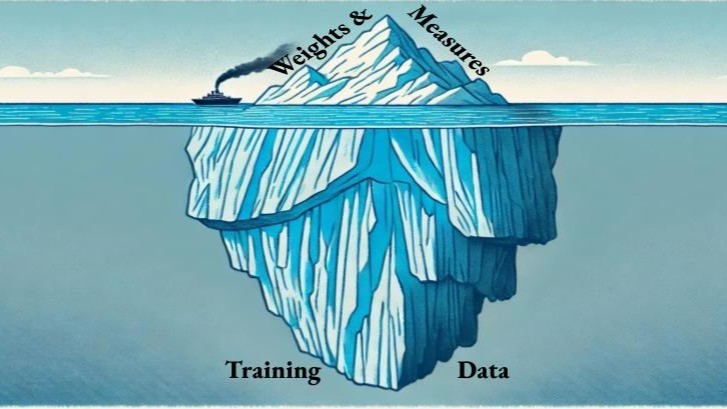Leadership Articles

On Product Strategy
Most product strategy failures come from misalignment between market needs and product vision, between engagement metrics and actual value, or between short-term wins and long-term sustainability. Success comes from ruthless clarity: knowing the real customer, the real differentiator, and the real path to scale.
Read More
Interviewing Leaders: Common Questions
Understanding a leader’s philosophy isn’t just about what they say—it’s about how they think, how they make decisions, and how they navigate complexity. This exercise distills the essence of my leadership approach by answering some of the most critical and commonly asked questions in executive interviews.
Read More
Understanding True Transparency in AI Models
AI transparency isn’t about knobs and dials—it’s about training data and reinforcement. No AI company has provided true transparency, and the token release of weights and biases offers only the illusion of openness. Without knowing what shaped the model, we cannot assess its behavior, validity, or trustworthiness.
Read More
Would You Hire Yourself?
Would you hire yourself? It’s a question we rarely ask—and one that cuts straight to the heart of a troubling disconnect in modern organizations. Companies celebrate initiative, resilience, and growth in applicants, only to penalize those same traits in their own employees.
Read More
Delegate, Trust, Evaluate
Return-to-office mandates are a symptom of a bigger problem: leaders struggling to operate at the right level of abstraction. Smaller companies move fast because their leadership is close to the action, but as organizations grow, leaders face an uncomfortable shift—delegating, trusting, and focusing on strategy instead of familiar hands-on work. RTO policies often stem from a desire to regain control, but they risk stifling productivity and engagement.
Read More
Logical Conclusions
As leaders, every decision you make sets off a chain of events. Too often, we overlook where those events might lead or how they could take unexpected turns. This isn’t about intelligence or ambition—it’s about iterative thought: the ability to follow ideas through multiple steps to their logical outcomes. Yet, even those trained in analytical fields often fail to fully anticipate unintended consequences.
Read More
A Job Well Done
Going above and beyond is a hallmark of excellence—but is it always the right call? In the pursuit of mastery, how do we balance the need for efficiency with the desire to do a job too well? Sometimes, the right fix isn’t about perfection; it’s about knowing when good enough is truly good enough. Let’s explore the art of striking that balance and giving our teams the right guidance to shine—without breaking the clock (or the bank).
Read More
Happiness at Work
Happy employees aren’t just a perk—they’re the foundation of a thriving company. But what does it take to create a workplace where people feel valued, empowered, and fulfilled? Balancing autonomy, inclusion, purpose, and even the need for idleness, this guide explores how leaders can foster true happiness at work—without sacrificing results.
Read More
Evaluating Talent in the Age of AI
We often hold tight to familiar truths, even as the world reshapes itself around us. In the age of AI, the greatest skill is the ability to adapt, to abstract, and to see beyond the familiar. Those who evolve their thinking unlock new possibilities—transforming challenges into opportunities for growth. How we assess candidates must evolve alongside changing technology.
Read More
Hire for Skills, Not for Industry
When it comes to software development, your industry isn’t special. Great engineers solve problems, not sectors. Stop hiring for the industry they came from and start hiring for the skills they bring.
Read More
Leading in the Age of Remote Work: Managing Risks Without Losing Flexibility
Remote work offers freedom, but with freedom comes complexity. Many employees and even some employers seem unaware of the tax and compliance risks tied to working across state lines. If your team is embracing remote work, it’s worth exploring how multi-state compliance can impact your business—and how the right tools and policies can turn a potential headache into a competitive advantage.
Read More
AI-Assisted Coding and the Evolving Role of Engineers
While the AIs I've used are nothing shy of amazing, the thing they lack (almost necessarily) is exactly the quality that I value most in software engineers.
Read More
On Building Teams
Team building is about synergy, clear roles, and giving credit where it’s due (yes, even to the person who fixes the printer).
Read More
Beyond Metrics
In the nuanced world of metrics and human interaction, it's easy to get lost in the numbers, but what about the intangible aspects that truly make a difference? Trust, mentorship, and the invisible work behind the scenes play a pivotal role in driving genuine success.
Read More
The Hidden Costs of AI-Coded Products
Engineering is about more than writing code—it’s about solving problems, scaling systems, and building sustainable success. AI might be fast, but thoughtful engineering builds to last.
Read More
Understanding AI
Language thrives in nuance—our imperfect communication sparks invention and inspiration. AI, with its near-perfect training, risks constraining creativity. The magic lies in embracing the human-AI dynamic, leveraging our gaps and its precision to create something greater than either alone.
Read More
How Your Job Listing Impacts which Candidates You Attract
Tired of seeing job descriptions full of fluff and impossible demands? So are candidates. I wrote about how companies can align hiring practices with their goals, fostering honesty and attracting the right talent. Let’s ditch the platitudes and build better teams.
Read More
Makings of a Manager
Effective leaders know that numbers can’t capture everything. They invest time in understanding their teams and align their incentives with the company’s broader goals.
Read More
On Managing Abroad
Creating genuine cohesion in remote teams isn’t easy. It requires thoughtful leadership, structural changes, and a commitment to fostering trust and inclusion.
Read More
Evolving Leadership Interviews
Hiring leaders is about more than checking boxes. It’s about finding individuals whose principles align with your mission and whose perspectives challenge you to think differently.
Read More
Whose Job Can AI Do?
Whether you’re a creative, a technician, or a strategist, your job might look different in the future, but your humanity will always be the differentiator. Together with AI, we can achieve more than ever before.
Read More
You Hired the Wrong Candidate
Hiring engineers is one of the most critical, yet nuanced, responsibilities for any growing company. It’s easy to rely on familiar patterns, seeking candidates who reflect what we already know and do.
Read More
Love What You Do
We’ve all heard it: “Do what you love, and you’ll never work a day in your life.” It’s a beautiful sentiment, but in practice, it’s left many people disillusioned.
Read More
Practical Advice for Job Posts and Applications
The hiring process has become a maze of inefficiencies. Employers filter candidates through overly specific requirements, while job seekers bend over backwards to match every keyword and skill. The result? Frustration, wasted effort, and mismatched outcomes for everyone involved.
Read More
The Art of Team Leadership: Respecting Specialization and Motivating Collaboration
I came across post on LinkedIn about developers stepping outside their roles to meet business needs which compares software developers to football players who pitch in to defend when necessary. While the metaphor highlights adaptability and collaboration, it oversimplifies the complexities of modern software development and the challenges of effective team leadership.
Read More
"You treat us like adults".
Leadership is an art of expectations—set them low, and people will meet them; set them high, and they’ll rise. But the trick isn’t just setting the bar—it’s recognizing how people approach it and what they need to succeed.
Read More
Structure: the Key to Understanding AI
Structure is what turns chaos into clarity, and understanding it is key to unlocking AI’s full potential in your organization.
Read More
Unexpected Advice for Budget Cuts
The companies that thrive in uncertain times are the ones that value cooperation over competition, transparency over gamesmanship, and strategy over survival tactics. When cuts come, it’s not just about prioritizing ruthlessly—it’s about leading wisely.
Read More
Managing Vendors
Decoding vendor tactics isn’t just about skepticism—it’s about leadership. Great leaders ask the hard questions, challenge assumptions, and dig deeper than surface-level claims.
Read More
The Myth of Startup Productivity
Startups are promises about the future. They’re bets on what could be, not guarantees of what is. As leaders, your role is to guide your team through the transition from making promises to delivering on them.
Read More
Which Type of AI to Use
Artificial Intelligence (AI) is a broad field, encompassing various technologies designed to solve different problems. Each type of AI thrives on structure—the patterns and relationships in data that allow it to learn and make decisions. To understand when and why different types of AI succeed or fail, we must first recognize how structure informs their effectiveness.
Read More
The Bell Curve Trap
Humans are natural optimizers. We instinctively seek efficiency and balance, whether consciously or subconsciously, and this ability to adapt and streamline is what makes experienced professionals “senior.” But optimization has a dark side: it can encourage behaviors that undermine the very goals we aim to achieve.
Read More
Fast-track Failure
The modern workplace is fast-paced, often rewarding results over process, and celebrating rapid ascension as a mark of success. Yet, when it comes to promotions, time-in-grade matters—not as a gatekeeping relic of the past but as a critical component of developing genuine expertise.
Read More
Hiring GenZ
From Boomers to Gen X, Millennials to Gen Z, every generation has faced the same criticisms on their way into the workforce. But as Quartz points out, these complaints are rarely about the workers themselves. They’re about the failure of organizations to adapt.
Read More
Hiring a CTO
The Chief Technology Officer (CTO) plays a pivotal role in any tech-driven organization, but the ideal candidate varies greatly depending on the company’s stage, needs, and trajectory. Conventional wisdom on the topic, supported by industry insights, provides a roadmap for what to expect from a CTO at different phases of growth and how to avoid common pitfalls.
Read More
Playing the Long Game
Business leaders across industries face a constant tug-of-war: the pressure to perform today versus the need to build for tomorrow. We saw it play out dramatically during the pandemic in sectors as different—and yet as similar—as pharmacy and software development. Both tell a cautionary tale about the dangers of short-term thinking.
Read More
Legacy Code and Warcraft
Legacy code. Two words that can make any engineer groan. It’s messy, it’s clunky, and it often feels like it was written by someone with a grudge against future developers. I get it—voicing frustration is normal.
Read More
Lackluster
The tech industry wasn’t built by playing it safe. It was built by people who dreamed big, took risks, and believed in their ideas. VCs who reward boldness, founders who stick to their visions, and customers who demand better can reignite that spirit.
Read More
Cheating the Interview
It’s a growing concern: candidates cheating during technical interviews. Stories of candidates using outside help or leveraging AI tools during interviews have become increasingly common. Yet, how widespread is this trend, and more importantly, why does it happen?
Read More
Strategic Leadership in Tough Times
Leaders who can diagnose the prevailing interaction modes within their teams and implement targeted interventions will build resilient, high-performing organizations ready to thrive in any environment.
Read More
On Building Culture
Culture isn’t built overnight, and it isn’t built in a vacuum. It’s a system of shared beliefs, reinforced through action, storytelling, and trust. Whether you’re leading a squad, a department, or an entire company, your culture is what will determine your organization’s resilience, efficiency, and success.
Read More
Effective Diversity
Diversity in teams is a powerful driver of creativity, innovation, and resilience. It fosters a range of perspectives, enabling organizations to tackle complex problems with a broader toolkit of experiences and ideas. But, as with any tool, diversity must be wielded effectively.
Read More

The Risks of "Work From Anywhere"
Remote work has revolutionized the modern workplace, offering flexibility and empowerment to employees. However, approving a "work from anywhere" policy without thorough due diligence can expose your company to a myriad of legal, financial, and operational risks. What seems like a people-first policy can quickly turn into an existential threat to your business.
Read More
On Customer Support
The tech industry has a habit of chasing silver bullets for customer support: chatbots, self-service portals, omnichannel communication. Each new tool promises to revolutionize the way companies serve their users. Yet the results are often underwhelming. Why? Because the problem isn’t about the tools—it’s about the approach.
Read More
The Trap of Expertise
Too often, companies exclude engineers from product planning. The intention is noble: protect them from distractions so they can focus on writing code. But this approach fundamentally misunderstands many engineers and their motivations.
Read More
Hire the Pragmatist
A product manager who’s deeply passionate about the product seems like a no-brainer hire—especially if the product is designed for zealous, niche users. Their enthusiasm can drive innovation, ideation, and engagement with a particular group of users who live and breathe the space. But what if your goal is to attract a wide audience?
Read More
On Product Vision
In the lifecycle of any successful product, the notion of "vision" is a multi-faceted prism. The founder’s vision, the VC case, the marketing message, the sales narrative, and the product reality each represent a different angle of the same core idea, refracted by the unique priorities and constraints of each stakeholder.
Read More
What You Don't Notice
At its core, leadership is about bridging gaps: between what’s seen and unseen, between intent and action, and between individual tendencies and collective goals. Triggers for awareness help close these gaps, enabling leaders to act with clarity and empathy.
Read More
Return to Office
The debate around return-to-office (RtO) policies continues to heat up, with reasons ranging from oversight and control to team building and government pressure. But are these justifications valid—or are they rooted in outdated thinking?
Read More
Quality: Beyond Metrics and Checklists
There’s an undeniable magic in certain leaders, teams, engineers, and companies. You can’t always put your finger on it, but you know it when you see it. Something just works. Problems seem to evaporate. Solutions fall into place. Progress feels inevitable. But where does this come from? And why is it so hard to articulate?
Read More
Risks and Reporting
Risk management is a cornerstone of leadership, but it’s often misunderstood—and even more often misapplied. At its best, identifying risks brings clarity, focus, and alignment to an organization. At its worst, it devolves into an elaborate performance, with teams and managers playing to an audience rather than addressing real concerns.
Read More
Full-Stack, Full Circle
Full-stack, front-end, back-end, or something entirely new—titles matter less than the value each individual brings to the team. What remains constant is the need for curiosity, versatility, and the ability to evolve alongside our tools.
Read More
On Leadership
Leadership has been a topic of fascination and study for centuries. From military generals to corporate executives, from life coaches to philosophers, everyone has a perspective on what makes a great leader. Yet, at its heart, the essence of leadership is deceptively simple. A leader is a living, breathing contract—an anchor of certainty in an uncertain world. But this certainty is not the end of leadership; it is the foundation upon which all else is built.
Read More
The Leader’s Checklist
The dynamic of trust and leadership isn’t static—it evolves with every interaction, every decision, and every example you set. Whether through a grand vision, shared goals, or the day-to-day efforts of living your values, trust is the contract you sign with your team each day, renewed by your integrity and commitment.
Read More
Organizational Hierarchies
In the pursuit of efficiency, many organizations are experimenting with flatter hierarchies. Senior leaders trumpet the virtues of "lean management" and "fewer layers," positioning these moves as antidotes to complexity and bureaucracy. But what does efficiency truly look like in a leadership structure? The answer depends on the nature of the organization, the work it performs, and—critically—the context in which decisions are made.
Read More
The Kernel of Leadership
At its core, leadership is about embodying "goodness" in a way that resonates universally and inspires others to act in alignment with that goodness.
Read More
Return to Office
The debate around return-to-office (RtO) policies continues to heat up, with reasons ranging from oversight and control to team building and government pressure. But are these justifications valid—or are they rooted in outdated thinking?
Read More
